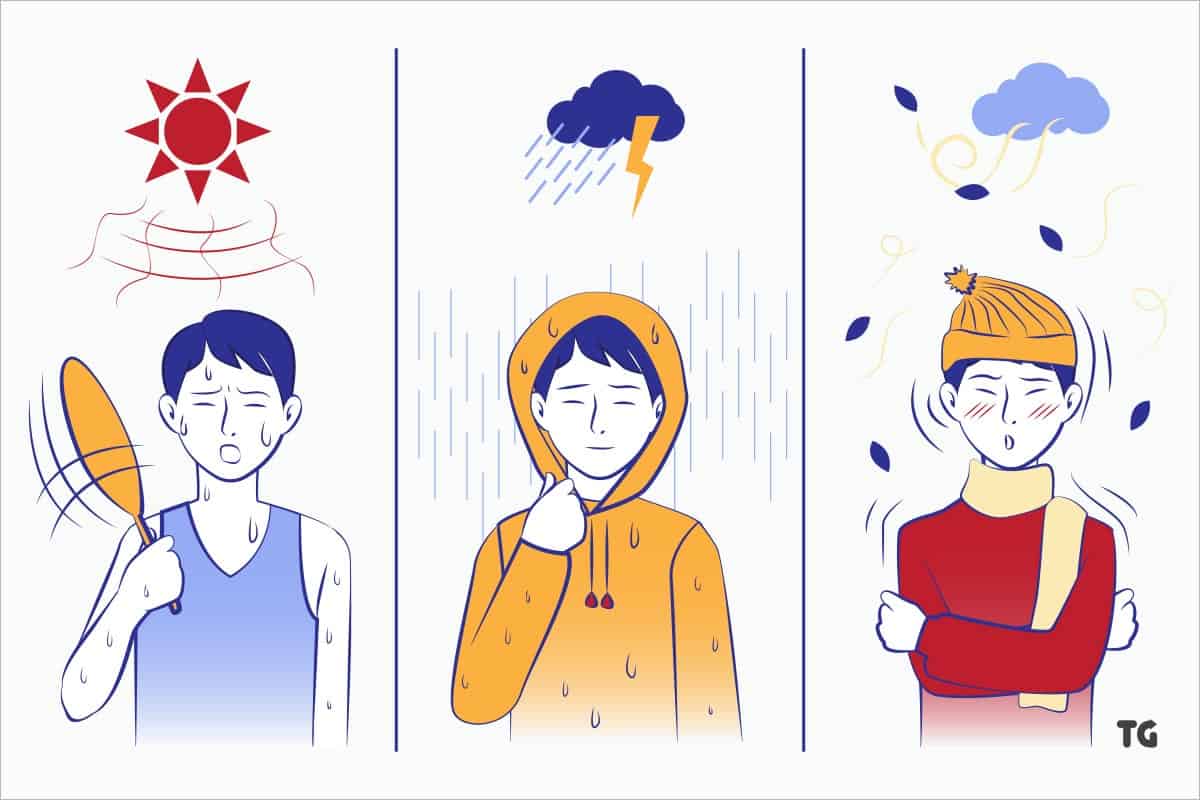Like its neighboring Southeast Asian countries, the weather in Thailand is mainly known to have a tropical climate, dry and wet (1). However, hot weather and sunny skies are not all there is to know about Thailand’s weather.
With its 3 weather seasons, the different regions across Thailand may have other weather conditions at different times of the year. Whether you’re a sun-worshipping beachgoer or a monsoon-hungry hiker, or anything in between, knowing what the weather is likely to do (at a particular time and place) will help pick out those perfect dates.
And you’ve come to the right place to help you do exactly that. This is a complete guide on the weather in Thailand – from what the data says about each season to the various climates in each region. So, if the weather is a significant factor in planning your next trip to Thailand, then keep reading.
An Overview on Thailand Weather (& It’s Seasons)
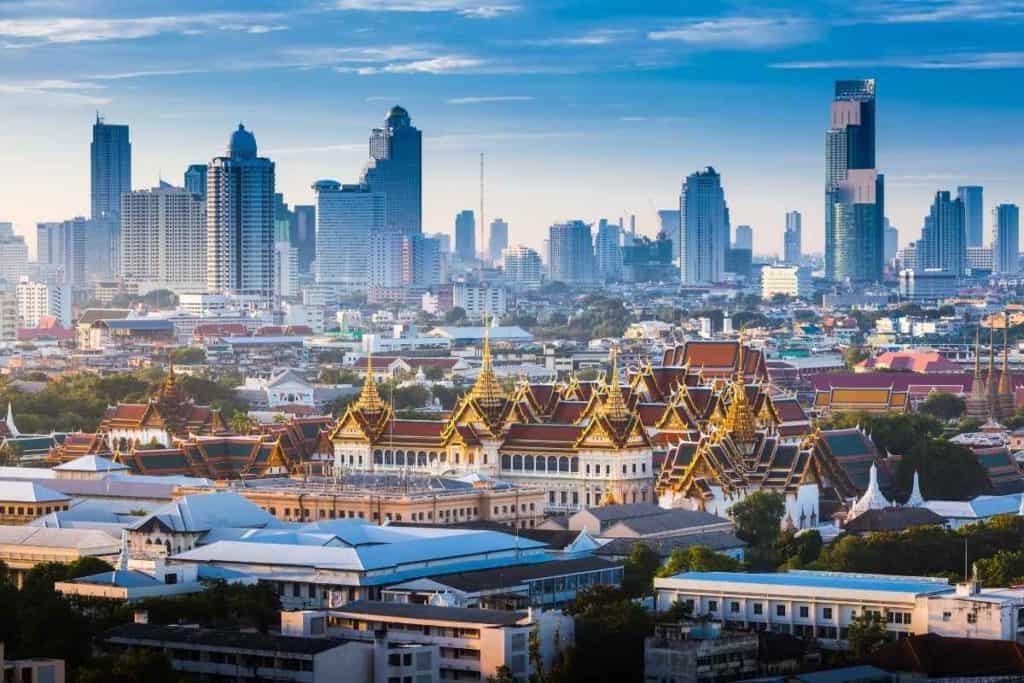
The weather in Thailand is under the influence of monsoon winds of season character – northeast monsoon and southwest monsoon.
The southwest monsoon in Thailand starts around May, bringing the warm, moist air stream from the Indian Ocean towards the country. This causes an abundance of rainfall in the country- especially on the windward side of the mountain areas (2). The southwest monsoon is not the only factor that causes rainfalls. The Inter-Tropical Convergence Zone (ITCZ) and tropical cyclones also bring considerable rain to the country (2).
The northeast monsoon starts in October and brings the dry and cool air from the anticyclone in China’s mainland region over the major parts of Thailand (especially to the northern and northeastern areas), with higher latitude. This northeast monsoon also brings mild weather and a lot of rainfall along the eastern coast of southern Thailand.
The southwest monsoon usually starts around mid-May and ends in mid-October. On the other hand, the northeast monsoon typically begins around mid-October and ends in mid-February (2).
There are 3 different Thailand weather seasons; the summer season, the rainy season or monsoon season, and the winter season. To understand the differences between Thailand’s weather year-round, here’s what the weather is like in each season.
When is the Summer Weather in Thailand?

The summer or pre-monsoon season starts in mid-February and ends in mid-May (2). This is also known as the transitional period from the northeast monsoon to the southwest monsoons, as the weather becomes warmer, especially in the upper Thailand region (2).
During the summer season, the temperature in Thailand begins to rise from February, and temperatures tend to peak in April – which is considered the hottest month of the year (2, 3). For most parts of the country, the temperatures usually hover around the mid-30s (3). Due to the inland nature and tropical latitude zone, upper Thailand regions typically experience a long period of warm weather; this includes the central, eastern, northern, and northeastern parts of the country (2).
From March to May (which are the months with the hottest weather in Thailand), the peak temperatures can reach 104 °F (40 °C) or more – except for the coastal areas where the temperatures are toned down by the sea breeze (2).
Summer is also the best time to visit the beaches, as visitors can enjoy sunny weather with clear skies and take a walk along the beach without worrying about rainstorms (3). The famous Songkran Festival or the Thailand Water Festival also takes place in April. So summer is a good time to visit Thailand for those who don’t mind the scorching weather.
For this year (2022), it has been announced by Thailand’s Meteorological Department that the summer season will begin on March 2nd, 2022, and will last until mid-May. It has been expected that temperatures will increase above 95 °F (35 °C), while occasional tropical rainfalls are also likely (4).
Rainy Season in Thailand (or Southwest Monsoon Season in Bangkok):

The rainy season is known as the low season, as most visitors are not fans of the mix between the boiling temperature and the wet monsoon rains (3). This is the southwest monsoon season in Thailand, as it prevails over the country and brings abundant rainfalls.
The rainy season in Thailand starts from mid-May and can last till mid-October, with the wettest period of the year being August till September (2). The humidity can be pretty high during the rainy season, with dark clouds constant in the sky. Also, according to the annual rainfall pattern, most areas of Thailand generally receive 1,200 – 1,600 mm of rainfalls a year (2). Clear skies are rare to find in this monsoon period, except during June, which can have a few days of clear skies.
In upper Thailand areas, the onset of the southwest monsoon brings intense rainfalls, starting from mid-May till early October. The amount of rainfall usually peaks in August or September, and due to the heavy rain, floods may occur in some areas of Thailand during these months (2).
However, there is an exception on southern Thailand’s east coast; the abundant rain remains in this region until the end of the year, both during the southwest monsoon and at the beginning period of the northeast monsoon.
During the southwest monsoon season in southern Thailand, the west coast receives heavy rainfalls, peaking in September. In contrast, the east coast receives heavy rains peaking in November and through to January of the following year. Thus, the beginning of the northeast monsoon season. The wettest month in this area is considered to be November (2).
Winter Season in Thailand:

The winter season in Thailand starts around mid-October and lasts until mid-February. Even though there is still plenty of rainfall on the east coast of southern Thailand at the start of this period, winter in Thailand is considered the “dry season” (or the mild period of the year). It can get quite cold in upper Thailand during December and January (2).
During this season, the general weather condition is still sunny, with generally clear skies and some ‘cool’ mornings with temperatures around 68 °F (20 °C). Unlike in the summer season, there is a blowing wind during the winter, especially in the early mornings and evenings. It is more of a cool breeze than the hot and dry air during the summer (3).
The weather during the winter season is considered to have the perfect balance of the weather conditions, as the other 2 seasons can be either too hot or too humid. In Bangkok and the other central Thailand regions, the weather is usually warm and dry, with an average temperature of 27 °F (25 °C).
The beaches remain hot even in the winter. However, they will be extremely dry as the monsoon rainfalls have already been and gone in the months previous. For trekkers and people staying in the highlands in the northern regions of Thailand, one can expect a hot and dry type of weather during the day but slightly cooler temperatures at night during December (5).
The winter season in Thailand is considered the best season to travel to Thailand. The chances of getting rained on are minimal, and day and night temperatures are comfortable enough in most parts of the country – making this time of the year ideal for all types of travelers.
Weather Climates by Different Regions in Thailand
Thailand covers 512,000 square kilometers (or 198,000 square miles) of land, divided by four geographical regions.
The central region is the home to Thailand’s capital city, Bangkok, and the northernmost part is filled with mountains and forests. The northeast region consists of flatlands, while the southern region is the peninsula area with coastlines on both sides and hundreds of small islands (6).
As each region has different geographical structures, Thailand’s climate in each region is also different. Below are the different climates in Thailand, according to each area.
Weather in Bangkok:
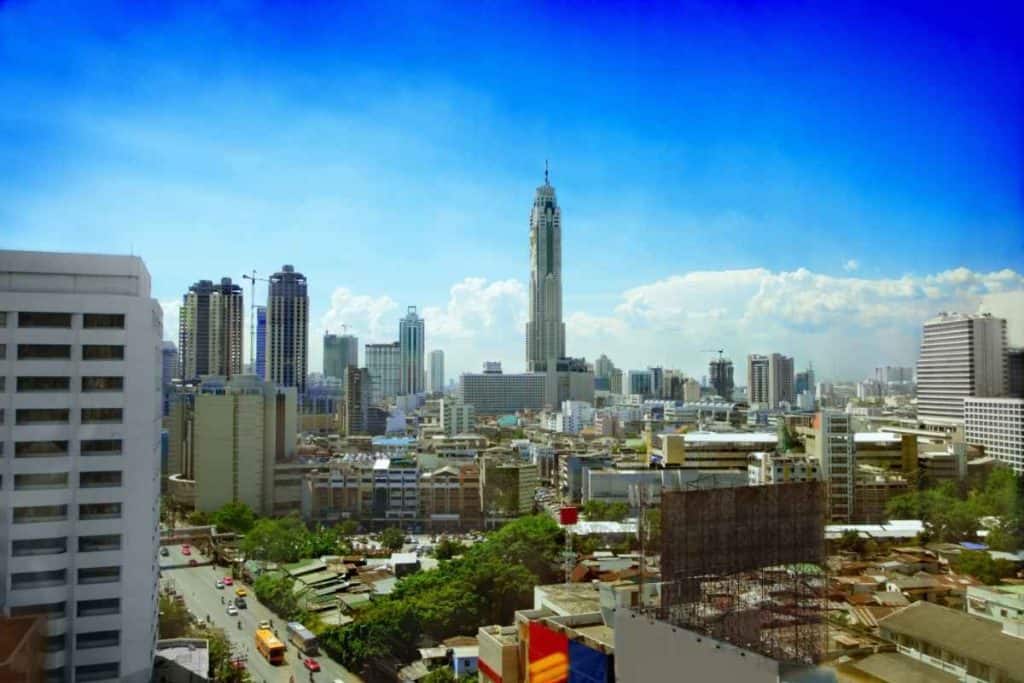
The capital city is located in the central region of Thailand, and humidity is pretty consistent in this region all year round. All 3 of Thailand’s seasons can be found here, as the seasons are more evenly spaced apart than they are in the other regions.
February to June is considered the hottest period in this region; the temperature rises in February, and the heat becomes intense between March and mid-May. During this period, the highs can reach 99-100 °F (37-38 °C) while the night temperatures continue to be hot. More often than not, it remains around 82-84 °F (28-29 °C) at night (7).
Bangkok’s monsoon season arrives around mid-May, and with that, the temperature starts to go down. The weather is often cloudy during this season, and humidity also increases. The rainfalls – which are in the forms of rain showers and thunderstorms, bring a bit of relief to this humid weather. Sometimes the downpours can be intense.
The rainiest months in Bangkok are September and October, which are the end of its monsoon season. The rainfalls during these months tend to be around 345 mm and 240 mm each month, respectively (7). In the dry season (from December to April), the amount of sunshine in Bangkok is excellent, with a clear sky on most days.
Bangkok’s weather is not as hot as in the north-central inland regions. However, it’s more humid due to the city’s proximity to the sea. Caused by a phenomenon known as the ‘urban heat island effect,’ the heat is trapped within the city, making the weather in Bangkok humid most of the time (7).
Weather in Pattaya:
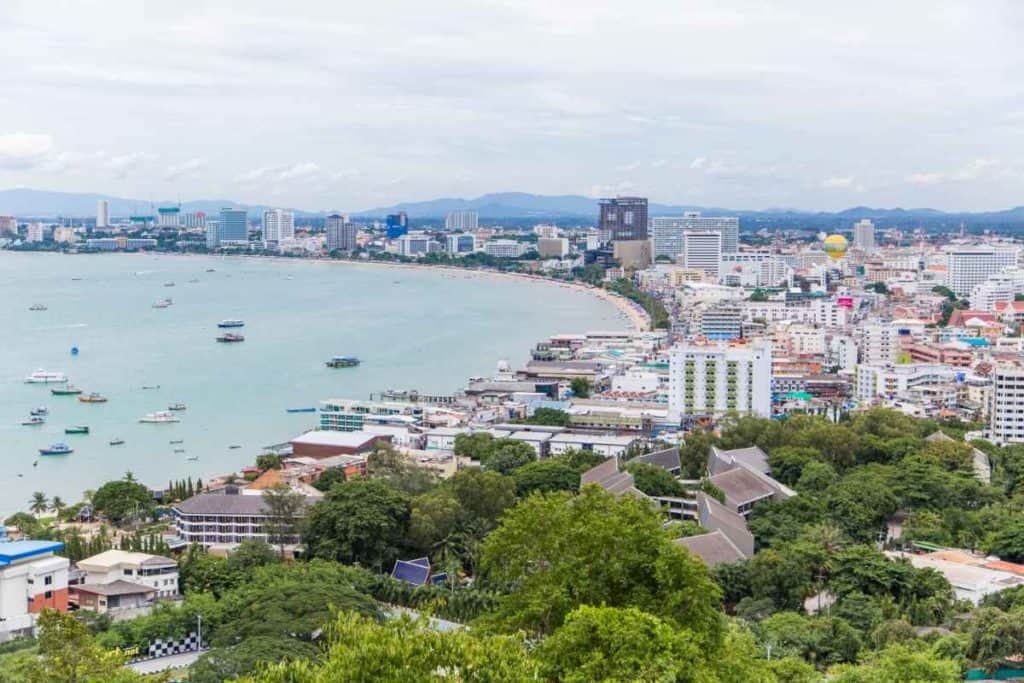
Pattaya is a beach town, and the ocean winds help reduce the heat in this famous tourist destination. The weather climate in Pattaya is similar to that of Bangkok. But as it is located on a stretch of coast, Pattaya is relatively sheltered from the summer rains (which occur from June to August), with an average of about 100 mm rainfalls per month (7).
During this hot and muggy season, there is not much sun. Tropical storms and typhoons can sometimes even affect the area. Therefore, visiting Pattaya from June to August is not so tempting.
The rainiest months in Pattaya are in May, September, and October, the beginning and the end of the wet season. The usual weather climate in Pattaya is that it doesn’t get too much rain, and it doesn’t get too uncomfortably hot as well. The average highs are around 88 °F (31 °C), and the lows are around 72 °F (22 °C) (8).
The best time for Pattaya’s weather is believed to be from December to February. March and April also have dry weather and sunny days, but the weather in these months can be a bit hot for visitors to enjoy the beach all day (7).
Weather in Chiang Mai:
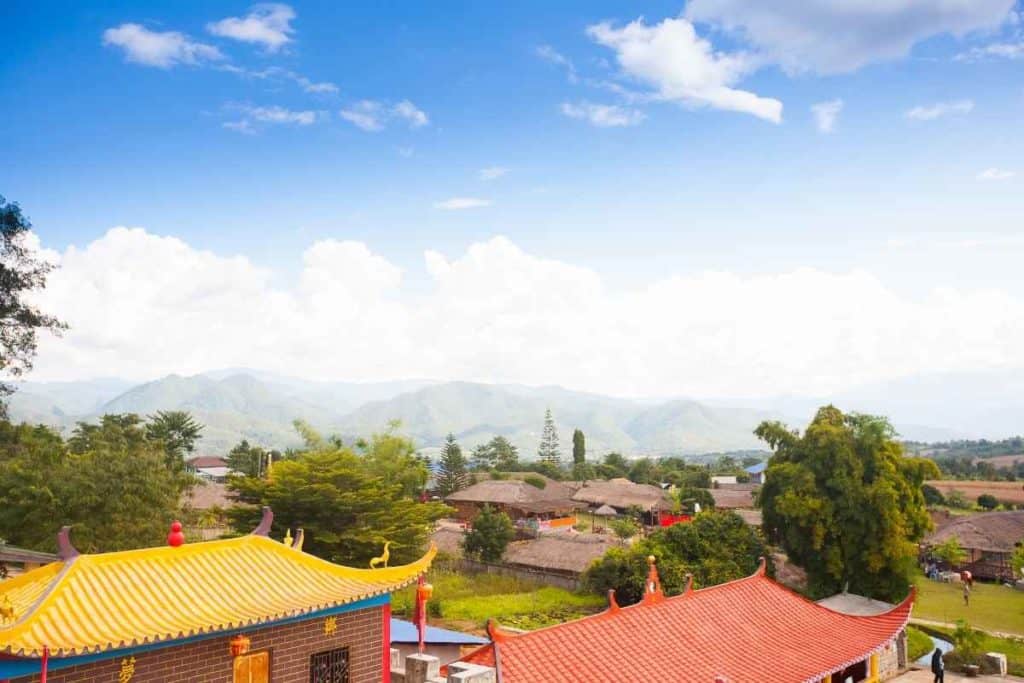
Known as the ‘cool weather capital,’ the weather in Chiang Mai is considered to be far more agreeable when compared to the sweaty heat of Bangkok (8).
In December and January, the night temperature in the northern cities like Chiang Mai can drop to around 41 °F (5 °C), as the cold air masses from China arrives in Thailand. In some cases, the temperature might reach even lower.
By February, the daytime temperature starts to increase and often reaches around 91-93 °F (33-34 °C) – with daily highs hitting 104 °F (40 °C) in some cases (7, 8). Then, the temperature rises to 95-99 °F (35-37 °C) between March and May – with peak temperatures even reaching above 104 °F (40 °C) (7).
The heat will continue through to June. Even though there is always humidity in Chiang Mai’s atmosphere during this period, the rainfalls won’t happen until the end of May (8). In the Chaing Mai region, the monsoon rains arrive in mid-May and last till mid-October.
The annual precipitation in the inland plain area of Chiang Mai is usually between 1,000 and 1,500 millimeters. The rainfalls happen with a similar pattern – rarely seen in mid-November to April but then heavy downpours during the monsoon season. These rainfalls reach their peak in August and September, which are the end of the monsoon period.
The sunshine is very good during the dry season in Chiang Mai, from December to April, as the clear skies prevail.
One thing to note about Chiang Mai is that due to the ‘slash-and-burn’ farming practices, a smoky haze may occur very frequently during the summer until July, which covers up the beautiful mountain sceneries, can also clog up your airways (8).
Weather in Phuket:

The most well-known island province in Thailand, the weather in Phuket is pretty much warm all year round. But there are months when this beautiful island is met with some wet weather (8).
The temperatures in Phuket during the winter season are a little higher compared to the east side, as the wind blows from the mainland, or rather, from the peninsula’s interior (7). April to May, and September to October, are considered the hottest times of the whole year in Phuket. The average temperatures are around 84 °F (29 °C), with a low of 73 °F (23 °C) (8).
However, this hot weather does not mean that there won’t be any rain during these months. Summer in Phuket can be stormy, as the monsoon hits directly from the sea to the coast (7). The rain in Phuket starts a bit earlier than in other areas of Thailand, as the majority of the rainfalls happen at the beginning of the monsoon season and sometimes around early May.
May to October is the monsoon season in Phuket, and one can expect to see between 18 to 23 days of rainfalls during a month. The average rainfall is up to 400 mm per month (8). Usually, September and October are the wettest months of the year. However, it is rare for the island to have more than two fully rainy days back to back. Often, rainfalls happen through the night, and by the morning, it is dry (8). From December to March, there is little rain in Phuket (7).
Though the temperatures in Phuket do not vary very much throughout the year, January is the month with the coolest average temperature – with highs around 90 °F (32 °C) and the lows being 72 °F (22 °C). November to February is considered the ideal time to visit this island for most travelers. The temperatures during these months are just a bit cooler, and the rainfalls are also scarce (8).
Conclusion
As the climate in Thailand is different according to seasons and regions, it is essential to check the weather beforehand so that your holiday plans won’t get disrupted. And generally speaking, Thailand is a lovely vacation destination all year round due to its generally warm weather.
However, the best time to visit Thailand can vary for different people. Therefore, to enjoy your holiday to the fullest, be sure to check the weather during the time of year and region you are visiting in Thailand. Lastly, here is a FAQ compiled for you to check the Thailand climate for each month at a quick glance!
Like always, if you want to discover more about Thailand, stay guided with ThaiGuider. You might learn something you never knew about this unique country.
FAQ: Weather in Thailand by Month (Year Round)
1. Thailand Weather in January
January in Thailand is one of the best and most popular months of the year to visit the country, as the weather conditions are favorable throughout the whole country. In January, there is little chance of rain, and all the west coast beaches are also likely to be covered by sunshine during this month – except for Koh Samui, as it often sees high levels of rain during this time of the year (9).
Average Temperature – 91 °F (32.7 °C) (10)
Rainfall – 12.7 mm (0.5 inches) (10)
2. Thailand Weather in February
The average temperature is around 22 to 25 degrees Celsius during February, making February an ideal month for outdoor activities (11). However, starting from February or mid-February, the temperature begins to rise. Towards the start of February, a few rain showers are also expected on the east coast of Thailand (12).
Average Temperature – 92 °F (33.3 °C) (10)
Rainfall – 20.32 mm (0.8 inches) (10)
3. Thailand Weather in March
Starting from March, temperatures will begin to increase throughout the country as the daytime temperatures peak at 35 degrees Celsius in the northern region of Thailand. The temperatures in the southern areas also start to rise with plenty of sunshine in the area (13).
Average Temperature – 94 °F (34.4 °C) (10)
Rainfall – 43.18 mm (1.7 inches) (10)
4. Thailand Weather in April
April is considered the hottest time of the year for Thailand, with average temperatures reaching 30 degrees Celsius frequently (14), with average temperatures for the highs being 35 degrees Celsius (10). Rainfalls are more frequent in April than in the first 3 months.
Average Temperature – 96 °F (35.6 °C) (10)
Rainfall – 91.44 mm (3.6 inches) (10)
5. Thailand Weather in May
Throughout the country, there is a welcome drop in temperature during May, even though the highs being 33-34 degrees Celsius is not unheard of (15). Most regions in Thailand also experience a noticeable increase in rainfalls, although it is not in all parts of the country (14).
Average Temperature – 94 °F (34.4 °C) (10)
Rainfall – 248.92 mm (9.8 inches) (10)
6. Thailand Weather in June
In June, the temperatures remain high, with an average of 29-31 degrees Celsius in many parts of Thailand (16). Any rain in June across much of Thailand is likely to be short downpours (16).
Average Temperature – 93 °F (33.9 °C) (10)
Rainfall – 157.48 mm (6.2 inches) (10)
7. Thailand Weather in July
Temperatures begin to drop a little in July, as the wind and rainfalls become more common as this month goes by (17). As the month continues, rainfalls increase, with short daily showers changing into more prolonged rains (18).
Average Temperature – 92 °F (33.3 °C) (10)
Rainfall – 175.26 mm (6.9 inches) (10)
8. Thailand Weather in August
As the rain is widespread across Thailand in August, it reaches its peak – especially in the north of Thailand, where heavy rainfalls are frequent (19). The temperatures also continue to drop slightly in August, although the humidity remains at a high level (20).
Average Temperature – 91 °F (32.7 °C) (10)
Rainfall – 218.44 mm (8.6 inches) (10)
9. Thailand Weather in September
September is considered the wettest month of the year, as the rainfalls continue throughout the country. Temperatures continue to go down gradually throughout September, and thunderstorms also happen this month due to the humidity level reaching its peak (21).
Average Temperature – 91 °F (32.7 °C) (10)
Rainfall – 335.28 mm (13.2 inches) (10)
10. Thailand Weather in October
Despite rainfalls continuing at the start of October, the temperature begins to drop, and so does the humidity level (22). In Chiang Mai, Chiang Rai, and northern Thailand areas, October is considered the start of the winter season as the temperature decline to a cooler level by the end of this month (23).
Average Temperature – 91 °F (32.7 °C) (10)
Rainfall – 292.10 mm (11.5 inches) (10)
11. Thailand Weather in November
By November, the rain becomes uncommon in many areas of Thailand as the sun returns to the country’s west coast, making it preferable to go to the beaches like Phuket and Krabi. However, there can still be high levels of rainfall in Koh Samui around this time. Temperatures also reach the ‘cool’ level by Thailand standard, especially in the early mornings and late evenings in the northern part of Thailand (24).
Average Temperature – 90 °F (32.2 °C) (10)
Rainfall – 50.80 mm (2.0 inches) (10)
12. Thailand Weather in December
December is known as the peak travel season as the weather for Thailand in December is comfortable for almost every part of the country. One can expect minimal rainfalls, plenty of sunshine, and favorable temperatures when visiting Thailand this month (25).
Average Temperature – 89 °F (31.7 °C) (10) (10)
Rainfall – 7.62 mm (0.3 inches) (10)
References
1. Selective Asia. Thailand: Weather & When To Go. Selective Asia. [Online] [Cited: March 1, 2022.] https://www.selectiveasia.com/thailand-holidays/weather/.
2. Climatological Group, Meteorological Development Bureau, Meteorological Department. The Climate of Thailand. Thai Meteorological Department. [Online] 2015. [Cited: March 1, 2022.] https://www.tmd.go.th/en/archive/thailand_climate.pdf.
3. Pete. Travel Guide: What Are Thailand’s 3 Seasons And When To Visit In 2022? Thaiger. [Online] February 8, 2022. https://thethaiger.com/travel/guides/travel-guide-what-are-thailands-3-seasons-and-when-to-visit-in-2022/.
4. Khaosod English. Khaosod English. Facebook. [Online] March 1, 2022. https://www.facebook.com/536126593072944/posts/5275368279148728/?d=n.
5. Becky. Best Time To Visit Thailand: Weather And Festivals Guide. Experience Travel. [Online] [Cited: March 2, 2022.] https://www.experiencetravelgroup.com/weather/when-to-go-thailand/.
6. Nam, Suzanne. Geography And Climate Of Thailand. Hachette Book Group. [Online] [Cited: March 2, 2022.] https://www.hachettebookgroup.com/travel/planning/geography-climate-thailand/.
7. Climates To Travel. Climate – Thailand. Climates To Travel. [Online] [Cited: March 2, 2022.] https://www.climatestotravel.com/climate/thailand/.
8. Peter. The Ultimate Thailand Weather Guide: Seasons, Regions, Rainfall & Temperature. The Thailand Life. [Online] October 8, 2019. https://www.thethailandlife.com/weather-in-thailand/.
9. Audley Travel. When Is The Best Time To Visit Thailand? Audley Travel. [Online] [Cited: March 3, 2022.] https://www.audleytravel.com/thailand/best-time-to-visit#jan/.
10. Nam, Suzanne. Weather In Thailand: Climate, Seasons, And Average Monthly Temperature. TripSavvy. [Online] December 4, 2020. https://www.tripsavvy.com/best-times-to-travel-in-thailand-1658236/.
11. Selective Asia. Thailand Weather & When To Go: February. Selective Asia. [Online] [Cited: March 3, 2022.] https://www.selectiveasia.com/thailand-holidays/weather/february/.
12. Audley Travel. When Is The Best Time To Visit Thailand? Audley Travel. [Online] [Cited: March 3, 2022.] https://www.audleytravel.com/thailand/best-time-to-visit#feb/.
13. Selective Asia. Thailand Weather & When To Go: March. Selective Asia. [Online] [Cited: March 3, 2022.] https://www.selectiveasia.com/thailand-holidays/weather/march/.
14. Selective Asia. Thailand Weather & When To Go: April. Selective Asia. [Online] [Cited: March 3, 2022.] https://www.selectiveasia.com/thailand-holidays/weather/may./
15. Selective Asia. Thailand Weather & When To Go: April. Selective Asia. [Online] [Cited: March 3, 2022.] https://www.selectiveasia.com/thailand-holidays/weather/may/.
16. Selective Asia. Thailand Weather & When To Go: May. Selective Asia. [Online] [Cited: March 3, 2022.] https://www.selectiveasia.com/thailand-holidays/weather/june/.
17. Audley Travel. When Is The Best Time To Visit Thailand? Audley Travel. [Online] [Cited: March 3, 2022.] https://www.audleytravel.com/thailand/best-time-to-visit#jul/.
18. Selective Asia. Thailand Weather & When To Go: July. Selective Asia. [Online] [Cited: March 3, 2022.] https://www.selectiveasia.com/thailand-holidays/weather/july/.
19. Audley Travel. When Is The Best Time To Visit Thailand? Audley Travel. [Online] [Cited: March 3, 2022.] https://www.audleytravel.com/thailand/best-time-to-visit#aug/.
20. Selective Asia. Thailand Weather & When To Go: August. Selective Asia. [Online] [Cited: March 3, 2022.] https://www.selectiveasia.com/thailand-holidays/weather/august/.
21. Selective Asia. Thailand Weather & When To Go: September. Selective Asia. [Online] [Cited: March 3, 2022.] https://www.selectiveasia.com/thailand-holidays/weather/september/.
22. Audley Travel. When Is The Best Time To Visit Thailand? Audley Travel. [Online] [Cited: March 3, 2022.] https://www.audleytravel.com/thailand/best-time-to-visit#oct/.
23. Selective Asia. Thailand Weather & When To Go: October. Selective Asia. [Online] [Cited: March 3, 2022.] https://www.selectiveasia.com/thailand-holidays/weather/october/.
24. Audley Travel. When Is The Best Time To Visit Thailand? Audley Travel. [Online] [Cited: March 3, 2022.] https://www.audleytravel.com/thailand/best-time-to-visit#nov/.
25. Selective Asia. Thailand Weather & When To Go: December. Selective Asia. [Online] [Cited: March 3, 2022.] https://www.selectiveasia.com/thailand-holidays/weather/december/.
THINKING ABOUT A TRIP TO THAILAND?
I am working on a FREE Thailand Travel Guide with a FULL 7 Day Itinerary. Be the first to receive it!
Thank you for signing up.
Something went wrong.
